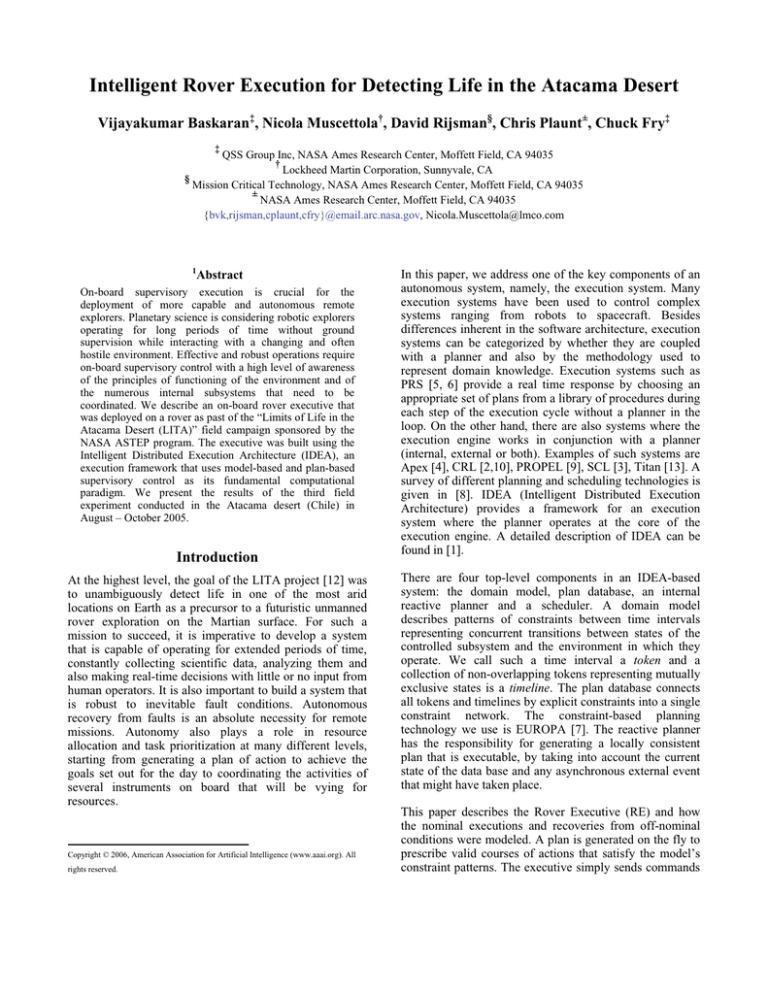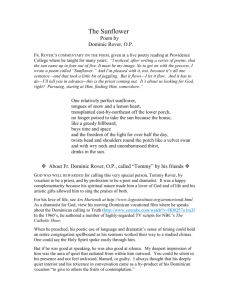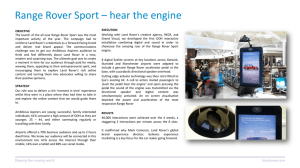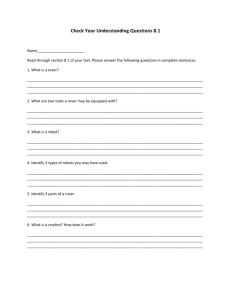
Intelligent Rover Execution for Detecting Life in the Atacama Desert
Vijayakumar Baskaran‡, Nicola Muscettola†, David Rijsman§, Chris Plaunt±, Chuck Fry‡
‡
QSS Group Inc, NASA Ames Research Center, Moffett Field, CA 94035
†
Lockheed Martin Corporation, Sunnyvale, CA
§
Mission Critical Technology, NASA Ames Research Center, Moffett Field, CA 94035
±
NASA Ames Research Center, Moffett Field, CA 94035
{bvk,rijsman,cplaunt,cfry}@email.arc.nasa.gov, Nicola.Muscettola@lmco.com
1
Abstract
On-board supervisory execution is crucial for the
deployment of more capable and autonomous remote
explorers. Planetary science is considering robotic explorers
operating for long periods of time without ground
supervision while interacting with a changing and often
hostile environment. Effective and robust operations require
on-board supervisory control with a high level of awareness
of the principles of functioning of the environment and of
the numerous internal subsystems that need to be
coordinated. We describe an on-board rover executive that
was deployed on a rover as past of the “Limits of Life in the
Atacama Desert (LITA)” field campaign sponsored by the
NASA ASTEP program. The executive was built using the
Intelligent Distributed Execution Architecture (IDEA), an
execution framework that uses model-based and plan-based
supervisory control as its fundamental computational
paradigm. We present the results of the third field
experiment conducted in the Atacama desert (Chile) in
August – October 2005.
Introduction
At the highest level, the goal of the LITA project [12] was
to unambiguously detect life in one of the most arid
locations on Earth as a precursor to a futuristic unmanned
rover exploration on the Martian surface. For such a
mission to succeed, it is imperative to develop a system
that is capable of operating for extended periods of time,
constantly collecting scientific data, analyzing them and
also making real-time decisions with little or no input from
human operators. It is also important to build a system that
is robust to inevitable fault conditions. Autonomous
recovery from faults is an absolute necessity for remote
missions. Autonomy also plays a role in resource
allocation and task prioritization at many different levels,
starting from generating a plan of action to achieve the
goals set out for the day to coordinating the activities of
several instruments on board that will be vying for
resources.
Copyright © 2006, American Association for Artificial Intelligence (www.aaai.org). All
rights reserved.
In this paper, we address one of the key components of an
autonomous system, namely, the execution system. Many
execution systems have been used to control complex
systems ranging from robots to spacecraft. Besides
differences inherent in the software architecture, execution
systems can be categorized by whether they are coupled
with a planner and also by the methodology used to
represent domain knowledge. Execution systems such as
PRS [5, 6] provide a real time response by choosing an
appropriate set of plans from a library of procedures during
each step of the execution cycle without a planner in the
loop. On the other hand, there are also systems where the
execution engine works in conjunction with a planner
(internal, external or both). Examples of such systems are
Apex [4], CRL [2,10], PROPEL [9], SCL [3], Titan [13]. A
survey of different planning and scheduling technologies is
given in [8]. IDEA (Intelligent Distributed Execution
Architecture) provides a framework for an execution
system where the planner operates at the core of the
execution engine. A detailed description of IDEA can be
found in [1].
There are four top-level components in an IDEA-based
system: the domain model, plan database, an internal
reactive planner and a scheduler. A domain model
describes patterns of constraints between time intervals
representing concurrent transitions between states of the
controlled subsystem and the environment in which they
operate. We call such a time interval a token and a
collection of non-overlapping tokens representing mutually
exclusive states is a timeline. The plan database connects
all tokens and timelines by explicit constraints into a single
constraint network. The constraint-based planning
technology we use is EUROPA [7]. The reactive planner
has the responsibility for generating a locally consistent
plan that is executable, by taking into account the current
state of the data base and any asynchronous external event
that might have taken place.
This paper describes the Rover Executive (RE) and how
the nominal executions and recoveries from off-nominal
conditions were modeled. A plan is generated on the fly to
prescribe valid courses of actions that satisfy the model’s
constraint patterns. The executive simply sends commands
to subsystems and receives message from sensors and
subsystems strictly following the plan. If the plan is
incomplete or violates the actual conditions of execution
(e.g., sensory messages) then it is extended or repaired.
The same occurs if new goals are communicated to the
rover.
Scope of the Rover Executive (RE)
There were several responsibilities levied upon the Rover
Executive (RE) in the LITA project. Foremost was to
execute a nominal plan consisting of navigational and
scientific activities laid out for the day. Goals were
specified by scientists working in a remote location
(Pittsburgh, PA) that were then up linked to the rover
operating in the Atacama desert via a satellite. Examples of
high-level goals are: commanding the rover to move to a
specific location, approach an area of interest and gather
scientific data or deploy a plow to dig a shallow trench to
collect information about sub-surface elements. The RE
was also responsible for handling faults by coordinating
the recovery process, the most important of which was to
quickly stop the rover before it puts itself in harm’s way.
We implemented the RE using IDEA and deployed it in the
Atacama desert as part of the 2005 field campaign between
August and October. The core of IDEA provided the
execution framework and also the necessary
communication services while the domain declarative
model captured the rover-specific behavior. Domain
models were developed in consultation with system
Operator
Interface
Start autonomous
operation
IDEA Executive
Request a plan
Mission
Planner
Plan (list of actions)
IDEA Core
(C++)
EUROPA/
PLASMA
Decl. Model
(XIDDL)
External
Planner
LitaRelay
MPRelay
CommRelay
Science on
the fly
Science
Planner
(Comm Relay)
microRaptor
(daemon)
Set position
Go to
waypoint
Fault Trigger/
Untrigger
Heartbeat
Navigator
Health Monitor
Stop/Start Rover
Position
Estimator
Science actions
Instrument
Manager
Vehicle
Controller
Figure 1 Interaction of the RE with other software
modules
engineers who were familiar with the rover hardware. The
RE ran on board the rover on a processor dedicated for
autonomy. In the following sections we present the RE in
greater detail and its interaction with other rover subsystems. We then provide a description of faults that were
handled, details of the declarative model that captures the
nominal and fault recovery scenarios and results of the
field experiment.
Overall Schematic
Interaction between the RE and the rest of the rover
software is illustrated in Figure 1. After all the processes
start up and reach a steady state, a human operator is
responsible for issuing a command to commence the
autonomous activity for the day via the Operator Interface.
The mission specification up linked from scientists prior to
the operator signaling the start of daily activity is then
forwarded without any modification by the RE to the
Mission Planner. The RE treats the Mission Planner as an
external entity and exchanges no information with it except
sending plan requests and subsequently receiving the
appropriate response. IDEA’s External Planner module
requests and then translates the plan received from the
Mission Planner into a local representation. The External
Planner interacts with the Mission Planner through a
communication relay (MPRelay) which publishes the
appropriate sequence of messages. The plan returned by
the Mission Planner is a series of actions that the rover is
expected to execute so as to satisfy the goals laid out by the
scientists for the entire day. For example, the Mission
Planner fills in waypoints that are approximately 30 meters
apart between the points of interest listed in the mission
specification. The end times of each of the actions (and
therefore the start times of the successive actions) specified
in the plan are time intervals thus making the plan a
flexible one.
When a complete plan arrives, the RE first loads it into the
EUROPA plan database. This is performed by the Goal
Loader, which is a part of the External Planner. The actions
that make up the plan are translated into tokens that are
then inserted into empty slots on a single goal timeline in
the same chronological order in which actions appear in
the generated plan. The final step of the goal-loading
procedure is to activate deliberative planning wherein
constraints consistent with compatibilities specified in the
domain description model are enforced via propagations in
the plan database. Since we already receive a full plan
from the Mission Planner, the deliberative planning does
not in this case have to fill in any gaps. It merely does a
temporal and constraint network consistency check to
ensure that the plan generated by the Mission Planner is
indeed a valid one.
Upon successful completion of the deliberative planning
step, the RE commences the first activity in the plan either
as soon as the External Planner finishes its task of loading
the plan in the database or at the earliest start time of the
first activity, whichever of the two events is later. For
every drive action that appears in the plan, the RE sends a
waypoint to the Navigator and expects a notification when
the rover reaches the intended destination. Similarly for
science actions, the RE directs its commands to the
Instrument Manager.
During nominal operation, the RE executes each and every
action in the order in which it appears in the plan. In
addition, the RE also makes sure that all actions start and
finish within the time bounds stipulated by the Mission
Planner. As can be expected, the behavior is different when
a fault occurs. Some of the faults are detected by the
Health Monitor which, by keeping track of heart beats
posted by different modules on a periodic basis, can infer
whether a particular module is still operating within normal
limits. The RE is inherently capable of detecting faults that
are temporal in nature such as actions completing before
(or after) a stipulated time interval. Details of fault
recovery steps coordinated by the RE are given in
subsequent sections. Any fault that has the effect of putting
at risk the completion of all the actions in a timely manner
results in the RE requesting the Mission Planner to
generate a new plan. When such a re-plan request is made,
the Mission Planner is informed of the list of unfinished
goals, the current time and position of the rover.
The RE also communicates directly with the Vehicle
Controller to set or clear the software emergency stop.
Setting the software emergency stop prevents the Vehicle
Controller from sending control commands to the microcontroller that actuates the wheels of the rover. The RE
also has the responsibility for broadcasting the initial
position of the RE to the Position Estimator.
The RE supports scenarios involving opportunistic science
(science-on-the-fly). A Science Planner runs on board and
gets activated whenever the Instrument Manager is asked
to perform a planned science activity. The Science Planner
sends a message to interrupt the RE to make allowances for
any follow-on activity that it thinks might be necessary to
explore the terrain for signs of life. The RE reacts by
suspending the planned end time of the science action that
is currently being executed and waiting for a signal to be
issued by the Instrument Manager marking the completion
of the follow-on action.
All communication between processes was achieved using
the publish-subscribe paradigm implemented in IPC [11].
Fault Handling
Except for faults that are temporal in nature, the RE is
informed of the occurrence (triggering) or the clearing (untriggering) of faults by the Health Monitor. After being
informed that a particular fault has occurred, the RE
coordinates the necessary steps to recover from it. In this
paper, we will not discuss strategies the Health Monitor
uses to detect faults, but focus on the recovery actions
coordinated by the RE. The RE deployed in the Atacama
desert was capable of coordinating the recovery actions for
10 different types of faults. The causes and recovery steps
for each of the faults are discussed below.
Early Completion of Actions: This fault is detected by
the RE and is triggered whenever actions are completed
before their earliest end time stipulated in the plan. An
inconsistency is triggered in the temporal network when an
action token (DriveAction or ScienceAction) is forced to
terminate before the allowed earliest end time by the
arrival of a completion status from an external sub-system
(Navigator or Instrument Manager resp.). The recovery
action is to issue a re-plan command to the Mission
Planner.
Timeout (late completion) of Actions: Similar to the
early completion fault, this is also detected by the RE when
an action has not completed by the latest end time. In other
words, the completion status of an action token
(DriveAction or ScienceAction) had not arrived from the
external sub-system (Navigator or Instrument Manager
resp.) before the scheduled latest end time. The recovery
action is to first send a command to cancel the action that
caused the failure and then issue a re-plan request to the
Mission Planner.
Process Crashes: These faults are triggered by the Health
Monitor when the Navigator, Position Estimator or the
Vehicle Controller crashes (stop sending heart beats). The
recovery is performed in multiple steps. In all three cases, a
software emergency stop command is issued right away to
make sure that the rover does not get into a hazardous
situation. In addition, the rover is put into a safeguarded
mode. Then we attempt to restart the process that crashed
by sending a request to a daemon that runs in the
background. This daemon, called microRaptor, is capable
of starting and stopping processes with the appropriate
command line options specified in a configuration file.
When a process gets restarted successfully, i.e., when the
RE receives a fault un-trigger message from the Health
Monitor, the rover is switched to the autonomous mode
and the software emergency stop is cleared. In the case of
Navigator recovery it may also be necessary for the RE to
resend the waypoint which the rover was heading towards
prior to the crash. Similarly, in the case of a Position
Estimator Crash recovery, it is necessary for the RE to
send the position of the rover prior to the crash.
No Arc Found Failure: This fault is triggered by the
Health Monitor whenever the Navigator is not able to find
a clear path ahead while the rover is moving towards a
waypoint. The responsibility of the RE is to send a
command to start the recovery action. In response to this
command, the Navigator performs a pre-determined course
of action, which is to reverse the rover. If no arcs are
visible even after the recovery maneuver, the Health
Monitor broadcasts another message to indicate that the
fault is still triggered. In response, the RE sends the
recovery command again. This cycle is repeated up to three
times, after which the control is handed over to the
operator. The RE does not actually tell what recovery
action to take, but just commands the Navigator to take
one.
Pose Uncertainty: This fault is triggered by the Health
Monitor when the error in estimation of the current
position of the rover exceeds a certain pre-defined
threshold. The recovery action is for the RE to just stop the
rover until the fault gets cleared. Stopping the rover gives
the position estimator an opportunity to refine and correct
its estimates by integrating data gathered from the suntracker.
Not On Map Fault: This fault is triggered when the rover
veers out of the boundary of an environment map
maintained by the Navigator. The recourse from this fault
is for the RE to cancel the waypoint that was previously
issued and then request the Mission Planner to send a new
plan given the current time and position of the rover.
Low Battery Power: This fault is triggered by the Health
Monitor when the battery voltage falls below a certain
threshold. The recovery action is to stop the rover and let
the battery get recharged using solar energy. The fault will
get un-triggered when the battery voltage reaches the
desired level.
Domain Model
The domain specific information of the RE is captured in
the declarative model that gets loaded during the
initialization process. It is written in a language we have
developed called XIDDL. XIDDL is an XML-based
domain description language and has the semantics to
define timelines, tokens and constraints (also called
compatibilities) that relate tokens within and across
timelines. To start the discussion on the model, we’ll first
look at the nominal mode of operation and then address the
more involved case of fault recovery. There are three main
timelines that form the backbone of the model. The
timeline MissionExecutive_SV, on which the Goal Loader
inserts action tokens received from the Mission Planner is
a
goal
timeline.
Two
executable
timelines,
RoverMobilty_SV and InstrumentManager_SV get
populated during the course of plan execution. Insertion of
tokens in the two executable timelines results in commands
being broadcast to the Navigator and Instrument Manager
modules, respectively.
Every DriveAction token in the MissionExecutive_SV
activates a GoToWaypoint token in RoverMobility_SV.
Activation of the GoToWaypoint token is achieved by the
“starts” compatibility in the model. The exact syntax used
in the model to achieve this is;
<define_compatibility>
<master type="single">
<class>RoverExecutive_Class</class>
<attr>MissionExecutive_SV</attr>
<pred>DriveAction</pred>
</master>
<subgoals>
<starts type="single">
<class>RoverExecutive_Class</class>
<attr>RoverMobility_SV</attr>
<pred>GoToWaypoint</pred>
<constraint name="eq">
<arg>x</arg>
<master>x</master>
</constraint>
<constraint name="eq">
<arg>y</arg>
<master>y</master>
</constraint>
<constraint name="eq">
<arg>z</arg>
<master>z</master>
</constraint>
</starts>
</subgoals>
</define_compatibility>
where, [x, y, z] is the waypoint in ECEF (Earth Centered
Earth Fixed) coordinates towards which the rover is
required to move. A similar constraint is defined between a
ScienceAction token in MissionExecutive_SV and
InstrumentManager_SV. Start of the GoToWaypoint token
results in an IPC command consisting of the [x, y, z]
coordinates being published to the Navigator. After the
rover reaches the waypoint, the Navigator publishes a
completion message that is handled by the RE.
Confirmation that the rover has reached a waypoint (i.e.,
the return status variable being set to “OK”) results in the
termination of the GoToWaypoint token that is currently
executing. GoToWaypoint then terminates the goal token
DriveAction via the “ends” compatibility defined in the
model as shown below.
<define_compatibility>
<master type="single">
<class>RoverExecutive_Class</class>
<attr>RoverMobility_SV</attr>
<pred>GoToWaypoint</pred>
<guard name="eq">
<arg>status</arg>
<value>OK</value>
</guard>
<guard name="eq">
<arg>statusFlag</arg>
<value>True</value>
</guard>
</master>
<subgoals>
<ends type="single">
<class>RoverExecutive_Class</class>
<attr>MissionExecutive_SV</attr>
<pred>DriveAction</pred>
<constraint name="eq">
<arg>rStatus</arg>
<value>OK</value>
</constraint>
<constraint name="eq">
<arg>statusFlag</arg>
<value>True</value>
</constraint>
</ends>
</subgoals>
</define_compatbility>
Figure 2 shows the interaction between the three timelines
that participate in the nominal scenario described above.
t1
MissionExecutive_SV
(goal timeline)
tx t2
DriveAction
starts
t3
DriveAction
starts
ends
RoverMobility_SV
t4
ScienceAction
starts
t5
DriveAction
End_Of_Day
starts
ends
GoToWaypoint GoToWaypoint
Stationary
GotoWaypoint
Stationary
(executable timeline)
to Nav from Nav
to Nav
ends
InstrumentManager_SV
IM_Idle
DoScience
IM_Idle
(executable timeline)
to IM
from IM
Figure 2 Nominal scenario
A simple plan consisting of three DriveActions and a
ScienceAction is inserted on the MissionExecutive_SV
timeline in the RE’s database. There is also a dummy
marker token called the End_Of_Day which signifies the
end of the plan. The first DriveAction is dispatched at time
t1. This results in the activation of the GoToWaypoint
token on the RoverMobility_SV timeline, which publishes
a command to the Navigator with the ECEF location of the
waypoint. When the RE receives a notification from the
Navigator that the rover has indeed reached the destination
at time tx, the executable token GoToWaypoint gets
terminated which then ends the DriveAction goal token.
The next goal action is then dispatched at time t2. The time
difference between t2 and tx will depend on the latency 2 of
the RE. Upon completion of the second drive action, a
ScienceAction goal token is dispatched at time t3. This
results in the insertion of a DoScience token on the
InstrumentManager_SV timeline in a manner very similar
to the interaction between the DriveAction and
GoToWaypoint tokens. The execution process is flagged as
complete when the End_Of_Day token gets dispatched at
time t5.
The model gets more complicated when fault recoveries
are involved. For each of the ten faults handled by the RE,
we have defined a triplet of timelines to intercept, register
faults and coordinate the recovery steps. An executable
timeline is used to intercept the message published by the
Health Monitor and post the appropriate information in the
database. Another timeline is used for registering the state
of a particular fault at any given time, i.e, it tells us
whether a fault is triggered or un-triggered. The third
timeline is an executable one which consists of tokens that
command the recovery sequence.
2
Latency is the sampling period with which the RE
operates.
Recovery from the Navigator process crash during a rover
traversal is illustrated in Figure 3. Let us consider the
scenario where the rover is heading towards a waypoint
and midway through the traversal, the Navigator crashes
and ceases to send heart beats to the Health Monitor. The
absence of heart beats will prompt the Health Monitor to
trigger a Navigator fault message which the RE, say,
receives at time t1. For the sake of simplicity we’ll ignore
the processing delay between the time the notification
arrives and the time when the RE commences the fault
recovery procedure. A message to trigger the fault is
posted to the database via a status variable of an executable
token called NavCrashFault in FaultNotification_SV. In
the domain model, we have specified compatibilities to be
enforced when the status variable of NavCrashFault is
bound to a particular state, in this case a fault being
triggered. As can be seen in Figure 3, at time t1, the
FaultMode_SV transitions from a NoFault state to a Fault
state. In addition, FaultRecovery_SV shows the activation
of a token SStopSet which results in a software emergency
stop message being published to the Vehicle Controller.
t1
RoverMobility_SV
t2
t4
t3
GoToWaypoint
Stationary
(exec timeline)
Publish waypoint
atGoalNotifiction
to NAV
FaultNotification_SV
from NAV
NavCrashFault
NavCrashFault
NavCrashFault
(exec timeline)
Fault triggered by HM
Fault untriggered
by HM
FaultMode_SV
Mode (NoFault)
Mode (Fault)
Mode (NoFault)
(Mode timeline)
FaultRecovery_SV
Nominal
SStopSet
Restart
ResendWP
Publish stop
Publish command
Publish waypoint
Command to VC
To microRaptor
To NAV
Nominal
(exec timeline)
Figure 3 Navigator process crash recovery
After a pre-specified duration of one latency, at time t2, a
command to restart the Navigator is issued by the RE to
the microRaptor daemon as a result of the Restart token
being activated on FaultRecovery_SV. After the Navigator
comes up and starts sending stable heartbeats to the Health
Monitor a message is broadcast to signal un-triggering of
the fault at time t3. The fault un-trigger message is also
posted to the database via the status variable of the
NavCrashFault token, as was done when the fault was
initially triggered. The RE reacts to this by resending the
waypoint coordinates towards which the rover was headed
when the Navigator crashed. One latency after the RE
resends the waypoint, the FaultMode_SV is reset to a
NoFault state.
The example described above illustrates a scenario in
which the recovery process completes successfully and,
more importantly, before the latest end time of the drive
action during which the fault occurred. Since there is still a
possibility for the rover to reach its waypoint before the
latest end time specified in the plan, it is not necessary to
interrupt the original plan that is being executed. However,
if the drive action was scheduled to end at a time before the
recovery process completed, it would have been necessary
to discard the remainder of the original plan and request
the Mission Planner for a new plan immediately after the
recovery action completes.
Results
The RE was deployed on board the rover during the 2005
field campaign in the Atacama desert. Data from all the
logs collected in the field were analyzed from the point of
view of stability and robustness of the RE and also from
the perspective of the state of integration with the other
processes running on-board. As can be expected, an
undertaking of this magnitude, where there are 15-20
different software processes competing for resources and
working in coordination with each other, is bound to
stretch the limits of software integration. In addition, there
were several hardware components to be controlled and
operated in one of the harshest of environments. All
processes contributing to rover autonomy, such as the
Rover Executive, Mission Planner, Science Planner and
Science Observer ran on a dedicated Pentium 4, 2.2GHz
processor. A second processor was dedicated to the rest of
the rover software, such as the Navigator, Position
Estimator, Vehicle Controller, Health Monitor and various
Instrument Controllers. As a measure of robustness, we
collected information on the duration of operation of the
RE. Obviously, an executive that operates uninterrupted
for a long period of time bodes well for any autonomous
system in general. Looking at the duration of operation of
any process also sheds some light on the software
integration process as a whole. We ran into several
software startup and integration glitches that had to be
resolved during field operations. This resulted in processes
being started and killed manually in quick succession. We
have also collected information on all the instances where
the RE ceased to operate due to a fault of its own or forced
to operate under conditions it wasn’t equipped to handle.
Reasons for RE malfunction have been summarized in the
form of a histogram later in this section. We have also
gathered data on the faults that were triggered during the
entire course of the field operation.
Figure 4 shows a histogram of the duration of operation of
the Rover Executive. The start and stop times of every
single run of the RE were extracted from the log to
calculate the duration of operation per run. This analysis
sheds some light on the stability of the RE as well as
software integration. Over the course of about six weeks of
the field campaign, the RE was started a total of 322 times
in conjunction with the full suite of processes onboard the
rover. There were 145 instances where the RE run time
was shorter than five minutes. Except for a total of 27
instances, the run was manually terminated by the operator
to track down non-RE related problems. Of the 27
instances where the RE contributed to an aborted start, 9
instances can be narrowed down to problems inherent in
the RE implementation. The remainder of the RE
premature terminations were caused by corrupted input
data, spurious messages being sent from other modules and
similar protocol violations.
At the other end of the spectrum we had two instances
where the rover executive performed uninterrupted for
over four hours.
160
145
140
120
100
80
58
60
40
40
40
20
20
8
2
2
180-240
mins
240-300
mins
0
0-5 mins
5-15 mins 15-30 mins 30-60 mins
60-120
mins
120-180
mins
Figure 4 Duration of operation
Figure 5 is a histogram of the types of faults that were
triggered during the entire course of the field operation. In
each of the pairs of graphs, the bar on the left indicates the
number of times a particular fault was triggered and the bar
on the right indicates the number of times the rover
executive successfully took the necessary step(s) to rectify
the fault. The most commonly triggered fault was the
NoArcFound fault, which the RE successfully handled 380
out of a total of 396 times (96% rate of success). On seven
of the remaining 16 occasions, the NoArcFound fault was
triggered three times consecutively and the RE went into a
standby state as per the design and waited for the operator
to intervene and clear the fault. This typically happened
while negotiating a very rugged terrain, where backing up
the rover was not sufficient to clear the fault.
The second most frequently triggered fault was the early
completion of science action. The Mission Planner was
pessimistic about the completion time of science actions,
thereby allocating more time for such activities than what
was actually required. The RE successfully coordinated
recoveries for early completion of science action with a
success rate of 100%.
The success rate of handling NotOnMap fault was not very
high (only 58%). On three of the unsuccessful recovery
cases, the RE received a NotOnMap during the
initialization process at startup. This was the result of an
inconsistency between the state of the RE and the
Navigator. The problem was rectified during the course of
the field operation by requiring the RE to clear all
waypoints cached in the Navigator before requesting the
Mission Planner for a new plan.
that problem was resolved during the course of the field
operations.
450
16
14
396
380
400
14
350
12
300
10
250
8
200
6
11
8
150
4
7
5
3
3
2
100
2
69 69
0
30 27
1
1
2
2
2
6
2
6
12 7
E
ar
ly
In
co
rr
ec
t
N
ot
O
nM
ap
C
ra
sh
N
oA
rc
Fo
un
d
V
C
C
ra
sh
N
A
V
C
om
pl
et
io
n
of
D
riv
Ti
e
m
eo
ut
D
E
riv
ar
ly
e
A
C
ct
om
io
pl
n
et
io
n
of
S
c
ie
Ti
nc
m
eo
e
ut
S
ci
en
ce
A
ct
io
n
0
Tim es triggered
1
st
a
rt
"s
up
C
pe
o
nt
ci
ro
al
l
le
ch
C
r
a
o
tim
ra
nf
ct
eo
lic
e
tin
ut
r"
g
p
N
ar
oA
sin
rc
g
bu
an
g
d
A
tG
S
oa
pu
P
l
r
la
ev
io
n
us
e
co
nt
at
s
n
ta
G
in
oa
ed
lN
on
ot
Jo
ifi
ly
ys
ca
E
tic
nd
tio
ki
n
_o
ng
f_
w
D
ith
a
y
ou
ac
tf
tio
ol
n
lo
w
in
g
p
ro
ce
du
re
B
og
us
N
oA
rc
N
fa
ot
ul
O
t
n
U
M
n
kn
a
p
ow
du
n
rin
C
g
au
R
se
E
in
iti
al
iz
at
io
n
50
1
Successful recovery
Figure 5 Faults triggered
There were 55 occasions out of 322 instances where the
RE ceased to operate and Figure 6 identifies the range of
causes. There were 14 instances where the RE terminated
with a “controller_timeout” error. This typically happened
when the RE was not able to complete the reactive
planning cycle within one latency (3 seconds) due to CPU
starvation. When the RE succumbed to this situation, it
would automatically be restarted by the microRaptor
daemon. Therefore, a premature termination of the RE did
not always mean the end of an autonomous run because
mechanisms were put in place to restart the RE
autonomously and submit the remaining set of goals to the
Mission Planner without any human intervention.
A plan parsing bug in the Goal Loader module resulted in
the RE crashing on eight occasions. One particular plan
returned from the Mission Planner consisting of the
character “#” in the comment field exposed a bug in the
Goal Loader. Although there were eight instances of such a
crash, they all took place in succession when the operator
kept loading the same plan repeatedly before realizing the
cause.
On seven occasions conflicting messages were published
by the Navigator and the Health Monitor. Within a matter
of milliseconds, the Health Monitor triggered a
NoArcFound fault while the Navigator published a
message that it had reached the goal. Since this scenario
was not taken into account in the domain model, the RE
was unable to resolve the conflict. The problem was
eventually resolved by improving the interaction between
the Navigator and the Health Monitor.
On 11 occasions the RE was handed an empty plan from
the Mission Planner with only the End_Of_Day action
which is a dummy marker that denotes the last action in a
plan. The RE did not parse that special case properly but
Figure 6 Causes for RE crashes
Conclusions
The 2005 LITA field experiment successfully
demonstrated the usefulness of a model-based execution
system like IDEA. The Rover Executive played its part in
achieving the overall goals laid out for the project. Its
presence in the loop aided during both the nominal and offnominal situations, thereby reducing the burden on the
mission operators.
There were, however, several issues that were brought to
the forefront. The RE was found to be sluggish and wasn’t
quite realtime, considering it operated at a latency of three
seconds. Several improvements are being actively explored
to streamline the IDEA framework. Current simulated
studies have shown that we are able operate the RE at a
latency of one second.
Acknowledgments: We thank David Wettergreen, Trey
Smith, Dominic Jonak, Paul Tompkins, Vandi Verma,
Michael Wagner and the rest of LITA project team at the
Robotics Institute, CMU. In addition, we thank Conor
McGann, Michael Iatauro and Peter Jarvis of the EUROPA
team at NASA-Ames for their support and Lee Brownston
for reviewing the paper with utmost diligence. This project
was funded by the NASA ASTEP program.
References
1.
2.
Ashwanden, P,. Baskaran, V et al. Unified Planning
and Execution for Distributed Autonomous System
Control. AAAI Fall Symposium on Spacecraft
Autonomy. Washington D.C. 2006.
Bresina, J.L. and Washington, R. Robustness via
Run-time Adaptation of Contingent Plans.
Proceedings of the AAAI Spring Symposium:
Robust Autonomy, Stanford University, CA, 2001.
3.
4.
5.
6.
7.
8.
9.
10.
11.
12.
13.
Chien, S,. Sherwood, R., Tran, D et al. Using
Autonomy Flight Software to Improve Science
Return on Earth Observing One. Journal of
Aerospace
Computing,
Information,
and
Communication . April 2005 .
Freed, M. Managing Multiple Tasks in Complex
Dynamic Environments. Proceedings of the
National Conference on Artificial Intellignece.
Madison WI, 1998
Georgeff, M and Lansky, A. Procedural
Knowledge. Proceedings of the IEEE Special Issue
on Knowledge Representation, Volume 74, pages
1383-1398, 1986.
Ingrand, F., Chatila., R, Alami, R and Robert, F.
PRS: A High Level Supervision and Control
Language for Autonomous Mobile Robots. IEEE
ICRA, Minneapolis, MN. 1996.
Jonsson, A and Frank, J. A Framework for Dynamic
Constraint
Reasoning
Using
Procedural
Constraints. 5th Internaltional Conference on
Principles
and
Practices
of
Constraint
Programming, 1999.
Kortenkamp, D, A Day in an Astronaut's Life:
Reflections on Advanced Planning and Scheduling
Technology, in IEEE Intelligent Systems Magazine,
April/March, 2003
Levinson, R. Unified Planning and Execution for
Autonomous Software Repair. Workshop on Plan
Execution: A Reality Check. ICAPS 2005.
Pederson, L., Smith, D., et.al. Mission Planning and
Target tracking for Autonomous Instrument
Placement. IEEE Aerospace Conference, 2005.
Simmons, R and James, d. Inter-Process
Communication v3.4, Carnegie Mellon University,
2001.
Wettergreen, D., Cabrol, N., Baskaran, V et al.
Second Experiments In the Robotic Investigation of
Life in the Atacama Desert. Proceedings of
iSAIRAS Conference. Germany, 2005.
Williams, B.C., Ingham, et. al. Model-Based
Programming for Fault Aware Systems. AI
Magazine, vol 24., no.4, 61-75. 2004.





